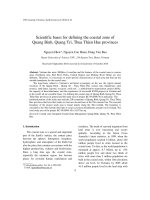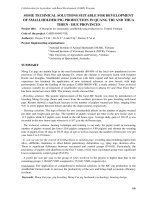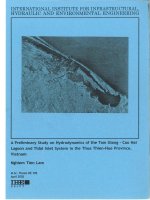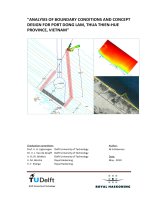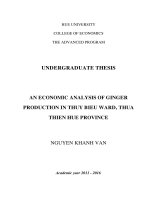Biological characteristics of the Japanese scad Decapterus maruadsi in Thuan An estuary, Thua Thien Hue province
Bạn đang xem bản rút gọn của tài liệu. Xem và tải ngay bản đầy đủ của tài liệu tại đây (667.87 KB, 6 trang )
TAP CHI SINH HOC 2019, 41(4): 125–130
DOI: 10.15625/0866-7160/v41n4.13891
BIOLOGICAL CHARACTERISTICS OF THE JAPANESE SCAD Decapterus
maruadsi IN THUAN AN ESTUARY, THUA THIEN HUE PROVINCE
Tran Thi Ngoc Anh1,2, Nguyen Xuan Huan1,3,
Tran Trung Thanh1,4, Nguyen Thanh Nam1,3,4,*
1
Faculty of Biology, VNU University of Science, Ha Noi, Vietnam
2
Research Institute for marine fisheries, Hai Phong, Vietnam
3
The Biological Museum, VNU University of Science, Ha Noi, Vietnam
4
Center of Life Science Research (CELIFE), VNU University of Science, Ha Noi, Vietnam
Received 24 June 2019, accepted 21 October 2019
ABSTRACT
A total of 257 Decapterus maruadsi individuals of collected from Thuan An estuary in Phu Vang
District, Thua Thien Hue Province were analyzed. Results showed that the fork length ranged
from 90 mm to 215 mm (160.2 mm on average) and mainly in the 140–180 mm range (86.8 %).
Of three age groups (0+ to 2+), the fished stock belongfrom is primarily to the 1+ age group
(63.8%) and 0+ age group (28.8%). Of five stomach fullness levels (0 to 4), the second and fourth
degree made up significantly proportions, being 29.6% and 31.5%, respectively. For the five fat
levels (0 to 4), the fourth degree made up 86.0%. The females to males ratio was 1.00 : 1.42.
von Bertalanffy’s growth model followed the equation: Lt = 203.77 × (1–e-0.3747(t+3.0272)).
Keywords: Decapterus maruadsi, biological characteristics, Thuan An estuary.
Citation: Tran Thi Ngoc Anh, Nguyen Xuan Huan, Tran Trung Thanh, Nguyen Thanh Nam, 2019. Biological
characteristics of the Japanese scad Decapterus maruadsi in Thuan An estuary, Thua Thien Hue Province. Tap chi
Sinh hoc (Journal of Biology), 41(4): 125–130. />*
Corresponding author email:
©2019 Vietnam Academy of Science and Technology (VAST)
125
Tran Thi Ngoc Anh et al.
INTRODUCTION
Decapterus maruadsi,a coastal pelagic
scad of commercial importance (Carpenter &
Niem , 1999) and high nutritional value, is
commonly harvested in tropical and temperate
seas in South East Asian countries. Among
the 4 Decapterus
species of Vietnam,
Decapterus maruadsi produces the highest
output, about 10% of production from bottom
trawl (Bui Dinh Chung et al., 1998), .
Recently, several researches on biological
characteristics of D. maruadsiwere published
by Le Tu Cuong (1985) in East sea; Bui Dinh
Chung (1988), Nguyen Viet Nghia (1999),
Hoang Ngoc Son & Vu Viet Ha (2016) in
Tonkin gulf. However, there was not any
information about Decapterus maruadsi in
Thua Thien Hue province. This research
studied
to
determine
length-weight
relationship, age structure, growth parameters,
sexual ratio and reproduction of D. maruadsi
to provide input data for assessing both stock
and exploitation status of this species in Thua
Thien Hue Province.
then placed on a slide with ridges down and
viewed through a microscope micrometer to
determine the age by counting the rings
(Scheneider, 2000).
For the length-weight equation (W = a×Lb,
where: W = total weight (g); L = total length
(mm); a and b = constant and coefficient),
least square method was used to determine a
and b.
Parameters of the von Bertalanffy growth
equations: Lt = L {1-e-k(t-t0)} and Wt = W {1e-k(t – t0)}b (where: Lt and Wt = fish length and
weight at the age t, respectively; L and W =
asymptotic length and weight; k = coefficient
of catabolism; t0 = arbitrarily adopted origin
of growth curve; b = exponent in the lengthweight relationship) were determined using
the methods of Berverton and Holt as
reviewed in Sparre (1993).
Feeding and production analysis follow
Pravdin (1973), in which the feeding intensity
and stage of sexual maturity of fishes were
presented by 5-grades scale (from 0 to 4) and
6-grades scale (from I to VI), respectively.
MATERIALS AND METHODS
RESULTS AND DISCUSSION
A total of 257 individuals of Decapterus
maruadsi were randomly collected from
catches of fishmen during field survey in the
neashore area of Thua Thien Hue Province
from 20th to 28th July 2015.
The total length (L), fork length (FL),
standard length (SL) and total weight (W)
under good conditions of fish samples were
measured according to the measurement
method of FAO (Carpenter & Niem, 1999).
Individuals were anatomized to determine sex,
stage of gonad maturity (Nilcolsky, 1963), the
degree of fat and the degree of stomach
fullness. Weights were measured again (WE)
after removing all internal organs.
The fork length of Decapterus maruadsi
from the research area ranged from 90 mm to
215 mm and mainly from 140–180 mm
(86.8%) (table 1). The mean of fork length
was 160.2 mm., the longer average fork length
of round scad in our research (July 2015). The
means of fork length in males and females
were 158.3 mm and 164.2 mm, respectively,
both longer than those in Tonkin gulf (Hoang
Ngoc Son, 2013) (145.4 mm and 148.7 mm) .
This may be due to fishes in the Thua Thien
Hue having spawned at an earlier time than
those in Tonkin gulf. In addition, the duration
of the collecting period and the number of
samples may not be large enough.
Scale samples were collected above the
lateral line and below the middle of the spiny
dorsal fin. Scales were firstly immersed into
Sodium hydroxide solution 3−5% for 30
minutes. 5 normal and complete scales were
The age of 257 specimens were ranged
from 0+ to 2+, with age 1+ fishes the most
common, accounting for 63.8% of the total.
The age 2+ group was least present (7.4%)
(table 2).
126
Biological characteristics of the Japanese scad
Group
1
2
3
4
5
6
7
Total
Age group
0+
1+
2+
Table 1. Fork length groups of Decapterus maruadsi
Fork length group (mm)
Number of specimens
80≤ FL <100
5
100≤ FL <120
4
120≤ FL <140
9
140≤ FL <160
107
160≤ FL <180
116
180≤ FL <200
11
200≤ FL <220
5
90–215
257
%
2.0
1.6
3.5
41.6
45.1
4.3
1.9
100
Table 2. Fork length ranges of Decapterus maruadsi
Fork length range (mm) Number of specimens Percentage (%)
90–157
74
28.8
156–189
164
63.8
170–215
19
7.4
Length-weight relationship
Relationships between fork length (FL)
and weight (W) were found to be:
W = 0.0004 × L2.3310 (R2 = 0.9291) (whole
stock).
W = 0.0005 × L2.2752 (R2 = 0.8589) (for
female).
W = 0.0004 × L2.3509 (R2 = 0.9457) (for
male).
The R value of all equations were higher
than 0.9, indicating good fits.
A value of b < 3 indicate that at the
beginning stage, fish mainly increased in
length. After having reached a certain size,
body weight increased faster than length. This
relationship differed between males and
females.
The b coeffecient was < 3 in other
researches in other researches, except for two
sites (table 3). This may occur due to different
number of samples, sampling time and
duration.
Figure 1. Relationship between weight and fork length of D. maruadsi in whole stock
127
Tran Thi Ngoc Anh et al.
Table 3. Comparing the coefficients of length-weight relationship model in different studies
Study sites
Whole stock
Male
a
b
a
b
0.0004 2.331 0.0004 2.3509
Thuan An estuary (this study)
Tonkin gulf (2012-2013)
(Hoang Ngoc Son & Vu Viet 0.8×10-5
Ha, 2016)
Tonkin gulf (1999) (Nguyen
Viet Nghia, 1999)
Tonkin gulf (1998) (Bui
Dinh Chung, 1998)
Thanh Hoa Province (2014)
0.0096
(Le Duc Giang, 2014))
South of Central Vietnam
(Bui Dinh Chung, 1998)
Juvenile
a
b
-
3.106 6.2×10-5 2.6959 6.1×10-5 2.6955 4.6×10-5 3.1975
2.83
-
2.87
-
2.84
-
-
2.533
-
-
-
-
-
-
3.096
0.011
3.033
0.009
3.121
-
-
2.602
-
-
-
-
-
-
Estimation of growth parameters
von Bertalanffy length and weight growth
equations for the caught fishes were
calculated to be:
Lt = 203.77 × (1–e-0.3747(t+3.0272))
Wt = 92.71 × (1–e -0.3747(t+3.0272))2.5291
The L∞ value in this study (203.77 mm) is
lower than previous values: 243 mm in center
gulf (Bui Dinh Chung ,1998), 286 mm in
near-shore and 258 mm in Thuan Hai area
(Binh Thuan and Ninh Thuan Provinces)
(Nguyen Xuan Huan, 1996). This partly
shows that this species is under pressure by
exploitation.
Feeding intensity
Figure 2. Degree of fullness of stomach in
caught fish
128
Female
a
b
0.0005 2.2752
Most collected stomachs were of degree 1
and 3 (29.6% and 32.5%, respectively). 10.9%
of stomachs were totally empty (Figure 2). It
can be infer that there was significant
competition in catching food between big and
small individuals, leading to a clear division
between second and fourth degree of stomach
fullness.
Fat analysis
The fat level of 257 fish individuals was
quite high. 221 samples were at level 3
(86.0%). Level 0, 1 and 2 accounted for
13.6%; only 01 male sample was at the level 4
(0.4 %). The male and female percentages
were 40% and 60% at level 0 and 60% and
40% at level 1.
Figure 3. Male, female and juvenile
percentages of fat levels
Biological characteristics of the Japanese scad
Reproduction analysis
The sex ratio of D. maruadsi was unequal,
being 1.00:1.42 with 100 females, 142 males
and 15 juveniles. 87.16% was at gonad stage
II; mostly in the 1+ age group (first
reproduction season), which is consistent with
the end of the breeding season in Vietnam
(Nguyen Viet Nghia (1999) , Hoang Ngoc
Son & Vu Viet Ha (2016)). This also shows
that exploitation in the study area during the
time of sampling did not affect the
resupplementation of the population.
CONCLUSION
The samples of Japanese scad collected in
Thuan An estuary in July were mainly
140−180mm and most of individuals were in
the 1+ old group. Von Bertalanffy growth
equation of Decapterus maruadsi in this area
was Lt = 203.77 × (1–e-0.3747(t+3.0272)), the L∞ =
203.77mm which was smaller than L∞ of
some studies estimated. At this time, the
fishes were relatively high fat level. In July,
the population of Japanese scad in Thuan An
estuary area had a higher proportion of male
fish and most fish were in stage 2 of gonad
maturity.
REFERENCES
Bui D. C., Chu Tien Vinh, Nguyen Phi Dinh,
1998. Some biological characteristics and
fisheries status of round scad (Decapterus
maruadsi) Indian mackerel (Rastrelliger
kanagurta) and Tunas in seawaters of Viet
Nam. Collection of researches for marine
fishes. Agriculture Publishing, Vol 1:
pp.132–141.
Carpenter K. E., Niem V. H., 1999. FAO
species identification guide for fishery
purposes. The living marine resources of
the Western Central Pacific. Volume 3.
Batoid fishes, chimaeras and bony fishes
part 1 (Elopidae to Linophrynidae), Food
and Agriculture Organization of the
United Nations.
Capenter, K. E., Niem, V. H.,1999. FAO
species identification guide for fishery
purposes. The living marine resources of
the Western Central Pacific. The living
marine resources of the Western Central
Pacific: vol 4 bony fishes part 2
(Mugilidae to Carangidae). Food and
Agriculture Organization of the United
Nations.
Chen G. B., Quiu Y. S., 2003. Study on
growth
mortality
and
reasonable
utilization of Decapterus maruadsi in
northern continental shelf waters of South
China Sea, Journal of Oceanography in
Taiwan strait, pp. 32.
Hoang N. S., Vu Viet Ha, 2016. Biological
characteristics of round scad decapterus
maruadsi (Temminck & Schlegel, 1843)
in the tonkin gulf. Vietnam Marine
Science and Technology, 16(2): 205−213.
Kimura S., Katahira K., Kuriiwa K., 2013.
The
red-fin
Decapterus
group
(Perciformes: Carangidae) with the
description of a new species, Decapterus
smithvanizi. Ichthyological Research, Vol
60: pp. 363–379.
Le D. G., Vu Viet Ha, Tran Van Cuong, 2014.
Determining the spawning season of some
marine fishes in Thanh Hoa province and
adjunction waters. Agriculture Publishing,
Vol 21: 90−95.
Le T. C., 1885. Growth of round scad in
East Eea Vietnam. Documentary sources
of Research Institute for Marine
fisheries, pp. 52.
Nguyen P. D., 1991. Biological characteristics
of Japanese scad Decapterus maruadsi in
seawater in Vietnam. The 3nd National
Conference on Marine, Science report
Collection,
Biology
and
Marine
Biotechnology, Marine Ecology, Vol 1:
pp. 36–45.
Nguyen P. D., 1998. Growth of round scad in
East sea Vietnam. Marine researches
collection, pp. 209–226.
Nguyen X. H., 1996. Growth and stock
dynamic and the catch ability of some
129
Tran Thi Ngoc Anh et al.
commercial fish species in the waters of
Binh Thuan - Ninh Thuan, summarizing
the dissertation thesis of Candidate of
Biological Sciences, University of Science
- VNU Hanoi, pp.24.
Nguyen V.N., 1999. Some biological
characteristics
of
Japanese
scad
Decapterus maruadsi and yellowstripe
scad Selaroides leptolepis in Vietnam.
130
Documentary sources of Research
Institute for Marine fisheries, p.151.
Scheneider J. C., Laaram P. W., Gowing H.,
2000. Age and growth methods and state
average, Manual of fishery survey method
II: with periodic updates, Michigan
Department of Natural Resources,
Fisheries Special Report 25, Ann Arbor,
pp. 148.

